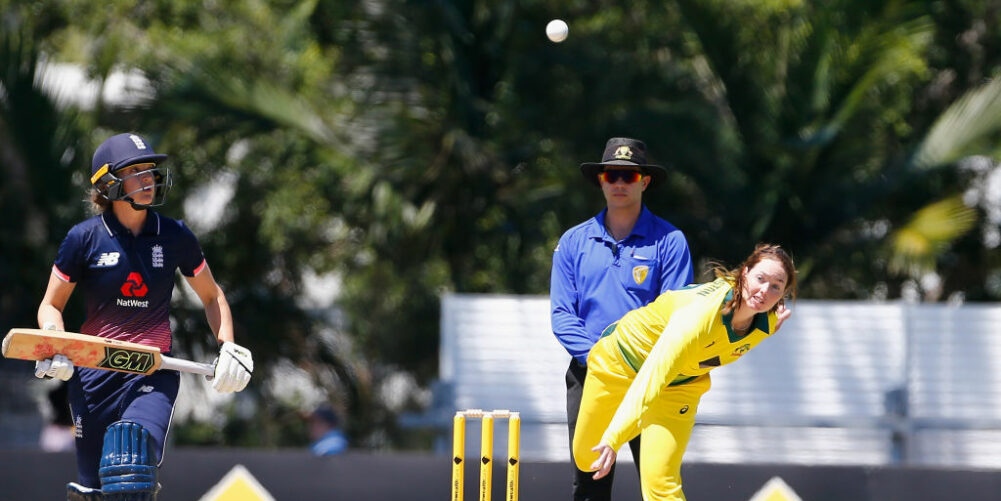By Alison Mitchell
The impact of Cricket Australia’s professional programme for domestic women could make itself apparent during the current multi-format Ashes series.
The first ODI in Brisbane was a close, fluctuating affair, with Australia coming away victors by just two runs with five balls to spare, thanks to veteran Alex Blackwell hitting a masterful, steely, 67 not out. However victory would have been much more difficult for Australia were it not for the performances of two 20-year-olds, who had only 16 ODI caps between them.
There is something thrilling, intriguing and compelling about watching a young leg-spinner rip and spin the ball, bamboozling the world’s best, and South Australia’s Amanda-Jade Wellington had England in knots when she was introduced into the attack in the 14th over at Allan Border Field.
She beat the edge of the bat, then found extra bounce, passing the shoulder of the blade as well. She was unlucky not to take a wicket in her 10-over spell, where she bowled a maiden and conceded just 39 runs.
On paper, it was a surprise that Wellington was chosen ahead of fellow leggie Kristen Beams, 32, who was Australia’s leading wicket taker at the recent World Cup. Wellington is, however, one of the most exciting talents in the world game at the moment, and she showed that she isn’t in awe of batting stars such as Sarah Taylor in the England line up.
Two years ago, at just 18, Wellington was in fact bowling into Taylor’s gloves when Taylor was keeping wicket for the Adelaide Strikers in the Women’s Big Bash. The fact that Taylor struggled to read her in the 1st ODI, despite having kept to her, spoke volumes about the youngster’s flight and control. She had the classic leg-spinner’s shape, dip, drift and turn. Taylor and Lauren Winfield had to knuckle down and play watchfully. They stopped taking risks against her.
Meanwhile, at the other end, pressure to score was growing on England, and off-spinning all-rounder Ashleigh Gardner, 20, started picking up wickets. Her 3-47 included the wickets of Taylor – lbw with Gardner bowling around the wicket – Natalie Sciver and Fran Wilson, for whom the necessity to score resulted in them both being caught in the deep trying to go on the attack.
Gardner’s final, impressive, contribution to the win was to join Alex Blackwell in the 43rd over of the run chase and nervelessly strike 27 off 18 balls to bring the target back within Australia’s sights and alleviate some of the pressure on Blackwell.
Whilst Gardner was a regular in Australia’s World Cup campaign, Wellington watched most of it from the sidelines. She fractured her finger in a warm-up match, meaning Beams played in the opening match against the West Indies, performed well, kept taking wickets, and kept Wellington out for the duration.
Despite her limited experience at international level, though, Wellington looked at home on the big stage of a televised Ashes series – a series that has the biggest profile of any international women’s cricket series ever played on Australian soil.
For this, one must acknowledge the impact of the Women’s Big Bash and the professionalism of all Australian women’s domestic cricket. The Women’s BBL will enter its third season in December. The promotional efforts of Cricket Australia and Channel Ten have ensured that matches are played in front of large crowds – in one instance 24,000 for the Melbourne derby on New Year’s Day. This means that by the time domestic players make the step up to international level, they are already accustomed to playing in front of TV cameras, with crowd noise and the associated pressure of a big match day.

The professionalism, which stretches across all state teams, not just the WBBL, means that the skills of a 20-year-old can now be as advanced and well honed as you might have expected of a 24-year-old under the old system.
Wellington also has an undisputed natural talent. This series could yet shape up as a tantalising battle of the spinner. For Wellington’s leg-spin, England have 24-year-old Alex Hartley’s left-arm spin. Both turn the ball away from the right hander and Hartley has already picked up a reputation as a taker of big scalps, after dismissing both Meg Lanning and Beth Mooney during the World Cup.
In the first ODI she enhanced that reputation by having Ellyse Perry stumped off a delicious delivery that turned past the bat when she shortened her length as Perry advanced. The remaining matches ought to be mouth-watering contests.
The series started in front of a sell-out crowd – partly a legacy of the televising and publicity of the World Cup and partly an extension of the momentum built around the first two seasons of the WBBL Down Under.
Cricket Australia are to be applauded for the bold and brazen way they are promoting this Ashes series. A serious marketing budget has gone into it, extending even to a Women’s Ashes chocolate bar being produced.
Their social media hashtag, #beatEngland, might have been vindicated in the opening match of the series, but England’s aim must be to embarrass the Aussies into wishing they’d never thought of it.












